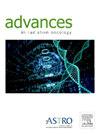Proton Therapy for Uveal Melanoma on a Pencil Beam Scanning Gantry
IF 2.7
Q3 ONCOLOGY
引用次数: 0
Abstract
Purpose
We present our experience treating ocular tumors in a standard pencil beam scanning (PBS) gantry room without apertures, which could broaden access to proton therapy for patients with ocular cancer globally. Besides, this study explores the dosimetric benefits of beam-specific apertures.
Methods and Materials
We retrospectively evaluated 11 consecutive patients with uveal melanoma treated in a clinic gantry room. The dose deviations between the planned and received by the patient were investigated by assessing the forward calculation of the treatment plan on the synthetic computed tomography of cone beam computed tomography. Each plan was forward calculated with a beam-specific brass aperture (BSA) using a Monte Carlo algorithm to explore dosimetric improvements. We compared the plan quality to the delivered plan (DP) using target coverage (D95%) and mean/maximum doses to the adjacent organs.
Results
A close agreement between the planned and delivered dose was achieved, with D95% deviations within 3.6% for all treatments, maintaining dose constraints for critical organs. Similar target coverage was reached, with D95% at 101% ± 1.0% (DP) and 101% ± 3.2% (BSA). BSA was effective (P < .05) in reducing the mean [DMean (DP, BSA)Gy] and maximum [DMax (DP, BSA)Gy] dose to organs: retina DMean (37.7, 29.5), cornea DMean (10.7, 2.4), conjunctiva DMean (13.6, 4.1), lacrimal gland DMean (25.5, 14.1), optic nerve DMean (19.6, 13.1), lens DMax (22.4, 8.5), cornea DMax (24.4, 10.2), eyebrow DMax (15.3, 6.8). BSA lowered the mean dose to surrounding organs and significantly decreased the maximum dose to nonabutting organs (lens, cornea, eyebrow), but had little impact on the maximum dose to the abutting organs (retina, optic nerve).
Conclusions
We demonstrate the successful implementation of ocular proton treatment with a standard PBS gantry beamline without apertures. The beam-specific apertures effectively reduced doses to the organs adjacent to the target in the PBS proton treatment while maintaining similar target coverage. This approach offers an opportunity to expand access to ocular proton therapy widely.
在铅笔束扫描架上质子治疗葡萄膜黑色素瘤
目的介绍在无孔标准铅笔束扫描(PBS)龙门室治疗眼部肿瘤的经验,为全球范围内的眼癌患者拓宽质子治疗的途径。此外,本研究还探讨了光束特定孔径的剂量学益处。方法和材料我们回顾性评估了11例连续在门诊室接受治疗的葡萄膜黑色素瘤患者。通过评估锥束ct合成计算机断层扫描治疗方案的前向计算,研究患者计划剂量与实际剂量之间的偏差。使用蒙特卡罗算法对每个计划进行了光束特定黄铜孔径(BSA)的正演计算,以探索剂量学的改进。我们使用目标覆盖率(D95%)和邻近器官的平均/最大剂量将计划质量与交付计划(DP)进行比较。结果计划给药剂量与实际给药剂量基本一致,D95%偏差在3.6%以内,维持了对关键器官的剂量限制。达到了类似的目标覆盖率,D95%为101%±1.0% (DP)和101%±3.2% (BSA)。BSA有效(P <;.05)降低器官的平均[DMean (DP, BSA)Gy]和最大[DMax (DP, BSA)Gy]剂量:视网膜DMean(37.7, 29.5),角膜DMean(10.7, 2.4),结膜DMean(13.6, 4.1),泪腺DMean(25.5, 14.1),视神经DMean(19.6, 13.1),晶状体DMax(22.4, 8.5),角膜DMax(24.4, 10.2),眉DMax(15.3, 6.8)。BSA降低了对周围器官的平均剂量,显著降低了对非邻近器官(晶状体、角膜、眉毛)的最大剂量,但对邻近器官(视网膜、视神经)的最大剂量影响不大。结论:我们证明了用标准的无孔PBS龙门光束线进行眼部质子治疗的成功实施。在PBS质子治疗中,光束特异性孔径有效地减少了靶附近器官的剂量,同时保持了相似的靶覆盖范围。这种方法提供了一个机会,扩大获得眼质子治疗广泛。
本文章由计算机程序翻译,如有差异,请以英文原文为准。
求助全文
约1分钟内获得全文
求助全文
来源期刊

Advances in Radiation Oncology
Medicine-Radiology, Nuclear Medicine and Imaging
CiteScore
4.60
自引率
4.30%
发文量
208
审稿时长
98 days
期刊介绍:
The purpose of Advances is to provide information for clinicians who use radiation therapy by publishing: Clinical trial reports and reanalyses. Basic science original reports. Manuscripts examining health services research, comparative and cost effectiveness research, and systematic reviews. Case reports documenting unusual problems and solutions. High quality multi and single institutional series, as well as other novel retrospective hypothesis generating series. Timely critical reviews on important topics in radiation oncology, such as side effects. Articles reporting the natural history of disease and patterns of failure, particularly as they relate to treatment volume delineation. Articles on safety and quality in radiation therapy. Essays on clinical experience. Articles on practice transformation in radiation oncology, in particular: Aspects of health policy that may impact the future practice of radiation oncology. How information technology, such as data analytics and systems innovations, will change radiation oncology practice. Articles on imaging as they relate to radiation therapy treatment.
 求助内容:
求助内容: 应助结果提醒方式:
应助结果提醒方式:


